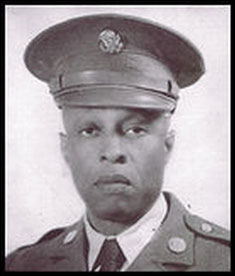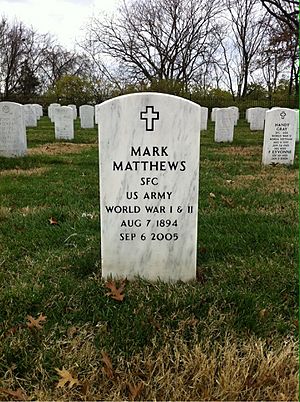Mark Matthews facts for kids
Quick facts for kids
Mark Matthews
|
|
|---|---|

Mark Matthews during his tenure as a Buffalo Soldier (date unknown)
|
|
| Born | August 7, 1894 Greenville, Alabama |
| Died | September 6, 2005 (aged 111 years, 30 days) Washington, D.C. |
| Place of burial | |
| Allegiance | |
| Service/ |
|
| Years of service | 1910–1947/9 |
| Rank | First Sergeant |
| Unit | 10th Cavalry |
| Battles/wars | Pancho Villa Expedition World War I World War II
|
Mark Matthews (August 7, 1894 – September 6, 2005) was an American soldier and a Buffalo Soldier. He was a veteran of both World War I and World War II.
Born in Alabama, Mark Matthews grew up in Ohio. He joined the 10th Cavalry Regiment when he was only 15 years old. To join, his age on documents was changed, as the minimum age was 17. While serving in Arizona, he joined General John J. Pershing's trip into Mexico. Their mission was to find Mexican general Pancho Villa.
Later, he moved to Virginia. There, he helped care for the horses of President Franklin D. Roosevelt and First Lady Eleanor Roosevelt. He was also part of the Buffalo Soldiers' drum and bugle band. When he was in his late 40s, he fought in World War II in the South Pacific. He became a First Sergeant. Mark Matthews was known for being an excellent shot and a great horse rider.
After leaving the United States Army, he worked as a security guard. He became the chief of guards before retiring in 1970. In his later years, he became a symbol for the Buffalo Soldiers. He met with important people like Bill Clinton and Colin Powell. Mark Matthews lived to be 111 years old. He was buried in Arlington National Cemetery. At the time of his death, he was the oldest living Buffalo Soldier.
Early Life and Joining the Army
Mark Matthews was born in Greenville, Alabama. He spent his childhood in Mansfield, Ohio. He started riding horses at a young age, delivering newspapers on a pony. When he was 15, he met members of the 10th Cavalry. This was one of the original Buffalo Soldier units. He met them while working with horses at a racetrack in Lexington, Kentucky.
The name "Buffalo Soldiers" referred to several special units in the United States Army. These units were made up of African American soldiers. Even though the official age to join the army was 17, Mark Matthews signed up. His documents were changed so he could join in Columbus, Ohio.
Military Service and Adventures
After his training, Matthews was first sent to Fort Huachuca in Arizona. At that time, the army still used Native American guides in the western United States. While in Arizona, he was known as a very good marksman.
Next, in 1916, he joined General John J. Pershing's trip into Mexico. This trip was part of the Pancho Villa Expedition. Their goal was to find Pancho Villa. Matthews said he never met Villa, but he knew where he was. During World War I, cavalry (soldiers on horseback) were not used much in Europe. So, the 10th Regiment stayed on the border with Mexico. They had small fights with Mexicans and German advisors near Nogales, Arizona.
In 1931, Mark Matthews moved to Fort Myer in Virginia. While there, he and his troops were escorts for King George VI and Queen Elizabeth of Britain. The King and Queen visited President Franklin D. Roosevelt at the White House.
Matthews was praised for his horse shows. These shows helped sell war bonds during World War II. He also took care of First Lady Eleanor Roosevelt's personal horses. He even played on the polo team while in Virginia.
He was also a member of the Buffalo Soldiers' drum and bugle corps. They played music at funerals in Arlington National Cemetery. This is where he would later be buried himself. At that time, African American soldiers were not allowed to be seen at funerals for white people. So, he had to hide in the woods while playing "Taps".
Ten years later, he fought in World War II. He saw combat during the Battle of Saipan in the South Pacific. During the war, he became a First Sergeant. He had first been sent to train with the Tuskegee Airmen. But he was considered too old for that training at the time.
Life After the Army
Mark Matthews left the army around 1947 or 1949. This was shortly before the Buffalo Soldiers units were ended. They were ended as part of President Harry S. Truman's plan to make the army integrated (meaning soldiers of all races served together).
His next job was as a security guard at the National Institutes of Health in Bethesda. By the time he retired for a second time in 1970, he was the chief of the guards. In his free time, he enjoyed fishing, reading the Bible, and telling stories about his many military experiences. These stories made him a popular person in his community. His wife, Genevieve Hill Matthews, passed away in 1986.
As he grew older, Mark Matthews became a symbol for the Buffalo Soldiers. In 1994, he met with President Bill Clinton at the White House. In 1997, when he was 103, Matthews attended a ceremony at Arlington National Cemetery. This event honored the Buffalo Soldiers. He helped unveil a plaque that dedicated his old barracks in their honor. For his 108th birthday in 2002, he met with Secretary of State Colin Powell. Powell was given a portrait of Matthews.
Mark Matthews was a member of his local church. He was also part of a Prince Hall Masonic Temple. He belonged to the Washington chapter of the 9th and 10th Cavalry Association until he passed away.
Even though he became partially blind from glaucoma by age 109 and completely blind from cataracts by 111, he still had a good memory and stayed healthy until his last days. He could walk without a cane and feed himself. He enjoyed telling stories from his military time. He never complained about his unit being segregated. Instead, he focused on his own achievements.
Mark Matthews died at the age of 111 from pneumonia in Washington, D.C.. At the time of his death, he was known as the oldest living former Buffalo Soldier. He was also the oldest man in Washington, D.C. He was survived by three of his four daughters, his son, nine grandchildren, and seventeen great-grandchildren. He was buried at Arlington National Cemetery in September 2005. Washington, D.C. Mayor Anthony A. Williams spoke at his funeral.


